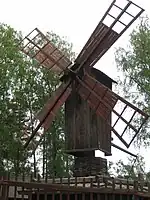
Seurasaari (Swedish: Fölisön) is an island and a district in Helsinki, Finland, known mostly as the location of the Seurasaari Open-Air Museum, which consists of old, mainly wooden buildings transplanted from elsewhere in Finland and placed in the dense forest landscape of the island.

Every summer, many Helsinkians come to Seurasaari to enjoy the rural, peaceful outdoor atmosphere. Despite the visitors, the island has a variety of wildlife, especially birds, but also red squirrels and hares. The height of the island's popularity is at Midsummer, when a huge bonfire (Finnish: juhannuskokko, Swedish: midsommareld) is built on a small isle just off the island's coast, and ignited by a newlywed couple. Thousands of people, both tourists and Helsinkians, watch the burning of the bonfire from both Seurasaari itself and from boats anchored near it.
Seurasaari also includes one of only two nudist beaches in Helsinki and one of only three in the entire country. Unlike the other nudist beaches, the beach is segregated for men and women separately with no unisex nudist area and is subject to a fee.[2]
Gallery
 The Granary, built in the North-Ostrobothnian style.
The Granary, built in the North-Ostrobothnian style. The Water Mill.
The Water Mill. The Tree Storehouse from Petsamo
The Tree Storehouse from Petsamo Storehouse from Utsjoki
Storehouse from Utsjoki Hay Cabin from Utsjoki
Hay Cabin from Utsjoki_Seurasaari.jpg.webp) Niemelä tenant farm.
Niemelä tenant farm. Building at Niemelä tenant farm.
Building at Niemelä tenant farm. Apotropaic mark on a farmhouse from Niemelä Tenant Farm
Apotropaic mark on a farmhouse from Niemelä Tenant Farm Pertinotsa farmhouse.
Pertinotsa farmhouse. Farm windmill
Farm windmill Clothes and food stores.
Clothes and food stores.
See also
References
- ↑ Merja Laavola: Eläinten elintasosairaudet näkyvät Seurasaaressa. Vartti Etelä-Helsinki, Sanoma Kaupunkilehdet, 2010. (in Finnish)
- ↑ "Nudist beaches and swimming places for dogs". Helsingin kaupunki. Retrieved 10 November 2017.
External links
60°11′N 024°53′E / 60.183°N 24.883°E
